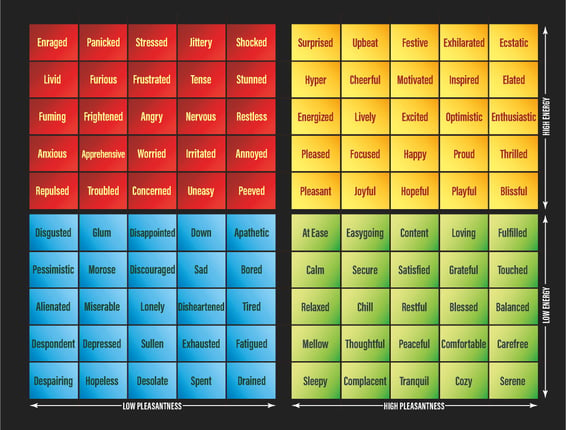Foundations of Emotional Intelligence
.png)
We have all been there–our son bursts into tears, starts screaming and arguing, avoid something to do, has trouble going to sleep, is resistant to start something, or does the opposite of what we request–these behaviors all signal to us that our child is experiencing big feelings. As parents, we often encounter these big feelings and corresponding behavior.
Good news! There are many ways you can help a child learn about and understand their feelings and behaviors. Of course, there is no one way that will work for all children. In fact, something that helps a child in one situation, might not work in another. Parents need to approach these moments with patience and be ready with several options for how to handle them.
Here are six ideas you can draw on when your child is confronted with big feelings—or just regular, every day, feelings. By practicing any or all of these tactics, you are guiding your child into a healthy awareness of, and relationship with, their emotions.
1. Remember, your child is good inside.
When confronted with a behavior that needs to be addressed, it is important to separate your child’s identity from their behavior. Clinical psychologist and author Dr. Becky Kennedy discusses this concept in her book, Good Inside: A Guide To Becoming The Parent You Want To Be. This key assumption can help guide how you handle tough behaviors and big feelings. In difficult moments, Dr. Kennedy shares it can be helpful to use language like:
- “You’re a good kid having a hard time. No matter what you do, I know you’re good inside;”
- “I know things feel tough right now, we will figure it out together;”
- or “two things are true, you want to drive your friends to the concert and you are not allowed to drive big groups places. You are allowed to feel disappointed”.
When you approach tough behavior with this mindset, it allows a space for children to experience their feelings and allows you as the parent to respond with empathy, while also holding a boundary if needed. Remembering that your child, and you, are good inside is a great place to start when facing challenging or extreme emotions.
2. Teach emotional vocabulary.
When your son is calm, teach him an expanded emotional vocabulary so he can recognize and label his feelings. Start simply by encouraging more descriptive words beyond the usual answers to “How was your day?” or, “How are you feeling?” Instead of ‘fine’ or ‘good’, maybe their day was ‘exciting’ and they are feeling ‘proud.’ In other situations, where a child might only be able to describe their feelings as ‘mad’ or ‘sad,’ help them to think of words that convey a more specific meaning like ‘irritated’ or ‘discouraged.’ This helps him communicate his feelings more effectively, which can lead to greater understanding and empathy between parent and child, resulting in fewer outbursts and difficult behaviors.
Dr. Marc Brackett explores labeling and understanding emotions further in his book titled Permission to Feel. In this book, he explores “emotional intelligence,” which he defines as “mental skills that enable us to think smarter, more creatively, and to get better results from ourselves and the people around us.” In other words, harnessing the power of all our emotions rather than squashing or fighting them. Dr. Brackett reminds us that emotions are information, and thinking about them as information helps us remove—strangely—emotion from the process and consider our feelings and the necessary purpose they serve in a new and productive way. He uses the acronym RULER as a way to remember this method of practicing emotional intelligence. RULER stands for Recognizing, Understanding, Labeling, Expressing, and Regulating. According to Dr. Brackett, “Recognizing, understanding, and labeling help to accurately identify and decode what we and others are thinking while expressing and regulating help us to manage these emotions to achieve desired outcomes.” In other words, in order to be able to express and regulate your emotions, your child first has to be able to recognize, understand and label their emotions.
3. Use a mood meter.
In our school, both teachers and boys use the mood meter developed by Dr. Brackett as a tool to assist in recognizing and labeling their emotions and determining how to respond. This chart allows a student to label his emotions across a spectrum as they relate to his current level of pleasantness and energy. The mood meter is broken into four quadrants that range from unpleasant, high energy (red) and to unpleasant, low energy (blue) over to pleasant, low energy (yellow) and pleasant, high energy (green). The chart is full of specific and descriptive words that are very useful when beginning, or continuing the RULER practice of recognizing, understanding, and labeling emotions. Our students start their day checking in with the mood meter and answering “How are you feeling?” Next to the mood meter are suggestions for how to respond, if needed. For example, if a boy identifies as being in the blue (e.g. sad, discouraged, disappointed, bored), they can talk to a friend or adult, take some deep belly breaths, repeat a positive mantra like “I am safe, I am loved,” or get a drink of water. This daily practice helps normalize and teach boys emotional vocabulary. You can find mood meter images online or in app form. One to try is The Mood Meter, by the company Emotionally Intelligent Schools.
 Copyright © 2022 Marc Brackett, Ph.D.
Copyright © 2022 Marc Brackett, Ph.D.
4. Validate.
Validating your child’s feelings and experiences helps them see that they are heard and understood. You can do this by saying things like “I hear you. It is okay to feel _____” or “I believe you, you feel ____”, even when you may not understand why they feel that way. It is important to remember that all feelings are okay to experience. Feelings are temporary. This may challenge an outdated model of encouraging children to suppress their emotions or follow strict gender stereotypes. It is okay for a child to feel worried or scared about going to football practice. It is okay to feel disappointed about forgetting homework at home. It is okay to feel stressed and panicked while managing multiple activities. Part of teaching your child how to emotionally regulate may mean approaching things differently than we might have been accustomed to. For example, saying things like “Quit crying, toughen up,” or “Don’t worry about it, you will be fine,” or “Don’t be scared, there is nothing to be afraid of” is dismissive of your child’s feelings. What you are doing in those moments is actually invalidating what they are feeling and experiencing, which can lead to shame and suppressing their emotions rather than managing and regulating them in a healthy and safe manner.
5. Teach and model how to respond to various emotions.
Once your son has recognized his feelings and labeled them, he can then learn to regulate them. This is where working together to generate ideas of coping skills can be helpful. For example, when I am working with a boy and he reports that he is feeling discouraged, I might say something like this: “You are feeling discouraged. It makes sense that you are feeling this way. You studied a lot for that test and it did not go well. It’s okay to feel discouraged. What are some things you can do to respond to this feeling?” We then generate ideas together. I may use “I wonder” statements if he needs help and say something like “I wonder if you could talk to a friend or take some deep breaths,” or “I wonder if you can ask your teacher for help on how to better prepare for the next test.” I also encourage parents to express their self-dialogue when they have and respond to a particular feeling. As we all know children learn to do as we do before they can learn to “do as we say,” and they are always watching.
6. Permit children to experience distress.
Allowing your child to experience uncomfortable feelings will help to foster your child’s ability to tolerate distress. This may be the most important takeaway in helping your child grow to be resilient and emotionally healthy. It is okay to experience unpleasant emotions and feelings, these are normal, and we all encounter these feelings throughout our lives. Feeling uncomfortable feelings and learning to handle them is a crucial part of developing resiliency and emotional regulation. In today’s world, we can be quick to want to fix our children’s problems or make them feel “happy.” However, your job as a parent is to allow your child to experience uncomfortable feelings so that he can first feel safe in his feelings and then subsequently learn how to productively respond to them.
As parents, we want to do what is best and most helpful for our child. When your child has big feelings or difficult behaviors, it can be all too easy to react in an unthinking and unproductive way. The next time your child is experiencing a challenging emotion, remind yourself that feelings are information, they are clues to what is going on, and the resulting behaviors are not the whole story. Take a breath, and take a moment—or three—or however many you both need.
When you are ready, start the conversation—use detailed words to label your emotions and help your child do the same. Then be sure to validate these feelings so that your child feels heard and understood. Together, think of ways to manage this emotion. If something has worked in a similar situation in the past, start there. If not, suggest ideas by using “I wonder” statements to get your child thinking about ways to harness this experience and these emotions to positive effect.
Gaining emotional intelligence is a lifelong endeavor. But by practicing these ideas, you and your child can learn to stop emotions from over-influencing actions. Learn to take emotions as they come and do your best in the moment. It won’t always work out perfectly, few things do, but it is a skill worth practicing.
If you are looking for additional information and/or support, you can reach out to your child’s school counselor, school psychologist, and/or school social worker. If you are looking for additional resources that are practical and easy to understand, check out Dr. Becky Kennedy’s resources (https://www.goodinside.com/about/) and the Big Life Journal (https://biglifejournal.com).
Mrs. Erica Evert is the Jr.K-8 School Psychologist and Student Services Department Chair at University School. Erica earned her B.A. in Psychology from Colby College and both her M.Ed. and Ed.S. in School Psychology from The College of William and Mary. Prior to coming to University School, she has served as a School Psychologist in Fairfax County Public Schools in Fairfax, Virginia and has worked at the elementary, middle, and high school levels. In addition to her work within the school buildings, Erica has also been a professional development trainer for over 24,000 employees.


%202.jpeg)
